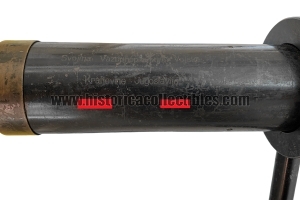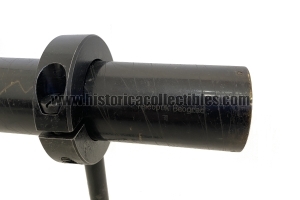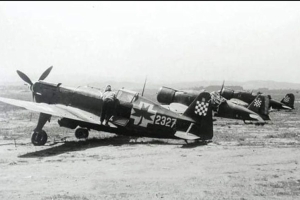Aircraft Sight, "Jugoslovensko Kraljevsko Ratno Vazduhoplovstvo i Pomorska Avijacija", 1934
Aircraft sight for machine gun fire installed near the cockpit, which allowed the pilot to fire at enemy aircraft with extreme precision during air combat, supplied to the "Jugoslovensko Kraljevsko Ratno Vazduhoplovstvo i Pomorska Avijacija" or "Yugoslav Air Force Naval Aviation" from 1929 to 1941.
In fact, thanks to the particular reticle, this sight was useful for defining the field of effectiveness of the projectiles and accurately framing enemy aircraft within the shooting area established by the reticle.
This sight, produced by "Teleoptik" of "Beograd" (Belgrade, capital of the Kingdom of Yugoslavia from 1929 to 1941), was installed exclusively on fighters and airplanes which were equipped with machine guns synchronized with the propeller.
On the body, in addition to the manufacturer's mark, the following words are shown: "Svojina Vazduhoplovstva Vojske" (Property of the Air Force), "Kraljevine Jugoslavije" (Kingdom of Yugoslavia) as well as the serial number "XXX", month "X" (October) and year of production "1932".
In this case the models on which it was used were the following:
Morane-Saulnier MS 406 aircraft
Avia BH-33
Caproni Ca.310
Its structure is extremely resistant, just as the brackets used for fixing to the nacelle are resistant, as it had to withstand pressure, turns etc etc without in any way changing the fin, elevation or position.
To date it is the only known example.
History of Teleoptik:
Teleoptik is a factory in Zemun, founded in 1922, and was the first Yugoslavian telephony, optics and precision mechanics factory. It remained active from 1922 until 1977 when bankruptcy was declared.
Serbia suffered serious damage during the First World War, therefore one of the most important tasks after the war was to rebuild the damaged railways and bridges, to then continue the construction of the railway lines started before the conflict and build a new railway network in areas which until then were not connected to each other. Investments in railway construction attracted the attention of various domestic and foreign companies. Among the first to appear were the Hungarian companies "SIS" and "Telefonska fabrika". The "SIS" company supplied signals, subsignals and bumpers for railway lines as well as complete telephone sets for railway stations. Thus the conditions were created to found the first Yugoslavian telephony, optics and precision mechanics factory which was officially put into operation on 22 April 1922. This marked the beginning of a new industrial branch in Yugoslavia: the mechanical engineering industry. precision, which was nothing more than a branch of the metal industry. The majority owner was the company "Telefonske fabrik a. D." from Budapest, which acquired the shares of the "SIS" factory. Famous domestic companies and industrialists also participated in the acquisition of company shares: Milan Vapa, Manojlo Klidis, Svetozar Vlajković, Milan Ječmenica, Vlajko Gođevac and others. The first regular session of the membership meeting was held on May 11, 1922. The manufacturing facility included a variety of instruments and signals. After four years the production program increased and the production of batteries and radios began.
The real success of the factory on the domestic market occurred with the development of air traffic: in ten years six aircraft factories, two aircraft engine factories and several aviation instrument and parachute factories were opened in the Kingdom of Yugoslavia. This also had repercussions on the first Yugoslavian telephony, optics and precision mechanics factory. Indeed, in 1927, the production of aviation instruments and devices began. One of the major obstacles to the faster development of the factory, in addition to the lack of capital, was the lack of qualified personnel. At the beginning of 1930, the name "Teleoptik" was added to the name of the company, then the name became "First Yugoslav Telephone, Optics and Precision Mechanics Factory Teleoptik a. D.". A few years later, probably starting in 1932, the name was changed to "Teleoptik a. D .".
The development of the factory made it necessary to construct a new building. For this reason, land was purchased in Zemun and at the end of July 1939 the factory was moved from Belgrade. Zemun, which was a border town before the First World War, developed rapidly in the interwar period and a large number of factories were built near the right bank of the Danube, around the railway station, on Tvornička Street (today Aleksandar Dubček), Tošina Bunar and Gornja Varoša. In 1934 Zemun was administratively annexed to Belgrade and, with the opening of the King Alexander Bridge, the left and right banks of the Sava were connected, which allowed direct connection with Belgrade. A year later the tram connection was launched and this meant that Belgrade industrialists began to invest in Zemun.
In 1940, the factory came under the control of the large international corporation "International standard electric corporation New York" (International standard electric corporation New York), which included a large number of telecommunications, optical and precision engineering companies in Europe and America. The factory operated successfully until the Second World War.
Referenze:
Storia Aviazione Jugoslava: Wikipedia
Storia Teleoptik: Wikipedia





